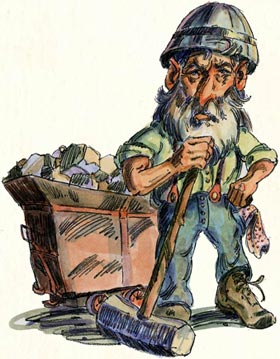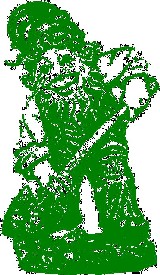Tommyknockers of Charter Oak Mine



The definition of what a Tommyknocker is has undergone several changes since they were first mentioned in the United States in the early 1800’s. Standing about 2 feet tall and greenish in color, some say they are spirits of departed miners helping the living to find ore or warning them of danger. They usually knock on mine walls right before a cave-in. Supposedly they have saved the life of many miners. It is also thought the first man to hear these sounds was jinxed, but not always.
But to the Cornish people these impish beings are the equivalent of Irish leprechauns or English brownies. Germans referred to them as Berggeister or Bergmännlein, meaning "mountain ghosts” or "little miners.” It was believed these diminutive people were the souls of Jews who crucified Christ and sent by the Romans to work as slaves in the tin mines.
Allegedly, they look like men and most often wear traditional miner’s gear. Whether they are good or evil is uncertain because they have been "known” to have committed both good and bad deeds. They often play practical jokes and are notorious for engaging in acts of mischief, such as stealing tools and food.


The Tommyknockers were first heard of in the United States when Cornish miners began working in the western Pennsylvania coal mines in the 1820’s. And in the 1840’s when the California Gold Rush began, these experienced Cornish miners were in big demand. They in turn sent messages back to kin folk in England inviting them to work in the mine fields. These people became known as “Cousin Jacks.” As a result their superstitions of the Tommyknockers spread and thrived.
The name Tommyknockers (pronounced knackers) comes from the knocking miners would hear on the mine walls, often just before a cave-in. Actually, the sounds were usually caused by the creaking of the earth or timbers. But to superstitious miners…they were made by Tommyknockers.
Although few claimed to have actually seen one, most agreed on what they looked like. They were about two feet tall, with greenish skin and hair and dressed in mining gear. They performed many duties working alongside the other minors. In fact, Cornish miners often refused to work unless mine owners guaranteed Tommyknockers were present.
No matter what they were called, Tommyknockers were said to lead miners to rich loads of ore by knocking on the rocks in the direction the miners should follow. On the other hand the knocking could also mean a cave-in.
However, Tommyknockers could also be malicious when offended. They would steal tools and lunches or throw rocks at the miners. They also blew out candles and lanterns or even refuse to signal a collapse. To keep on their good side miners often left part of their lunch or other small offering.
But some miners believed all Tommyknockers were inherently evil. In some cases mines were often forced to close because of superstitious beliefs.
It is also said when a mine petered out, Tommyknockers found work in homes around old mineshafts.
There was a mine said to be haunted by Tommyknockers called Charter Oak Mine in Montana. The haunted mine was rich in zinc, lead, cadmium, copper and silver. The Hopkins brothers started around the turn of the century establishing several state mining claims.
After one of the brothers had a heart attack, the mine was sold to James Bonner who lived there throughout the 1960s. However, the new owner was unaware the mine was draining toxic substances from ore tanks where metals were separated into the Little Blackfoot River. Bonner was forced to clean up the toxic mess, which included mercury, cyanide, zinc and cadmium, all substances used in mining. He surrendered his equipment to the Forest Service. A group of volunteers who wanted to restore Charter Oak Mine took charge of the task and cleaned up the environmental disaster at a cost of around $1.5 million dollars.
When one large mine closed in 1956, the Cousin Jacks claimed to hear Tommyknocker hammerings. The owners sealed the mines. However, Cornish miners sent a petition to the owners requesting they leave one opening so the Tommyknockers could move to other mines. The owners complied.
Charter Oak Mine’s historian and a visitor were by the compressor shed one day when they also heard knockings coming from the opening. They weren’t rocks shifting or dripping water. It was the sound of a metal hammer pounding against rocks.





